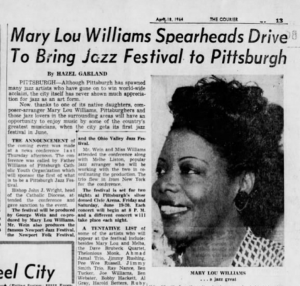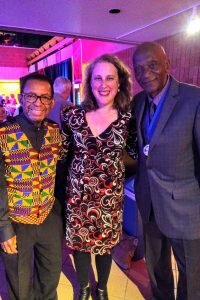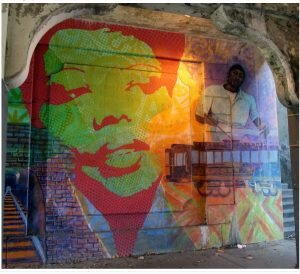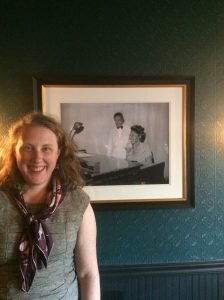The City Where Jazz is Love: Pittsburgh and Mary Lou Williams
Tomorrow will mark three weeks since my arrival in Pittsburgh. I initially came here for an engagement with my New York City trio; I chose to stay here for two months because of Mary Lou Williams and the musicians who keep welcoming me to their city and their bandstands.
There is something about “place” that can only be experienced and then, to a lesser extent, written about. Place seeps into our bodies, minds, spirits; affects our breath, our gait, our sense of how much space is available for us to take up on the sidewalk, in the grocery store, in a jazz club. New York and Pittsburgh are two very different places. Mary lived in both of them and now I’m following her history in parallel by spending time in her hometown.
Mary’s niece Bobbie Ferguson, who currently lives in Pittsburgh, once told me that Mary would come back here to relax, to be with family. While she occasionally performed here- and, indeed, co-founded the first Pittsburgh Jazz Festival in 1964- she visited to be with and to care for her loved ones. Occasionally Mary would bring clothes that she couldn’t sell at her thrift shop, stuffing them into her Cadillac and trying to sell them in the ‘Burgh. Sometimes she left Pittsburgh with family in tow, absconding with her sister Grace and her six children, taking them back to Manhattan to live in her Harlem apartment when they were in need.

It was in Pittsburgh where Mary learned in the fall of 1965 that her beloved spiritual director, Fr. Anthony Woods, SJ, had died of a heart attack at the age of 53. Mary got back in her Cadillac to return to New York in time for the funeral. It was also in Pittsburgh where Mary worked with Cardinal John J. Wright and Father Michael Williams of the Catholic Youth Organization. It was here where she taught at Seton High School and led thirteen girls from Seton in singing her first Mass in 1967 at the mammoth Saint Paul Cathedral in Oakland.

Many of these historical tidbits used to be bullet points that I tried to keep straight in my mind. But over the course of four trips to Pittsburgh since last December, and now during this extended stay, I am aware that these histories are part of the fabric that I walk in and among each day. I’ve attended Mass at Saint Paul and visualized Mary in that space; seen the old Crawford Grill- a place where, to my knowledge, Mary did not play, but knew of its centrality in the jazz community and the Hill District; fleetingly seen Mary’s face on a roadside mural while on a bus after worshiping at the welcoming Saint Benedict the Moor parish, where I stood up and introduced myself during the “welcome new visitors,” and where an older woman came up to me after Mass and said that she knew Mary. Others came up, saying that they saw me play Mary’s music with the Pittsburgh Symphony back in the spring; one man asked for advice for his twelve-year-old son who is writing songs. When I left, they said, “see you next week.”

It’s this welcoming, embracing aspect of Pittsburgh that I hear in Mary’s music. This city has produced so many titans of the jazz world, and its current jazz community is rightfully proud of its history. Last week I attended an event at Manchester Craftsmen’s Guild where five musicians were inducted into the MCG Pittsburgh Jazz Legend Hall of Fame which now includes twenty-nine stalwarts of the music. A few days later I saw my friend Dr. Harry Clark at an event sponsored by the African-American Jazz Preservation Society of Pittsburgh of which Dr. Clark is the president. Last December, Dr. Clark drove me through the Hill District, showing me the Crawford Grill and explaining the history of the formerly segregated musicians’ unions in this city.
At both of these events- where I am a visitor here to learn- I was invited to sit in and play. And both times, immediately after playing, older musicians came up to me wanting to talk, giving me hugs, offering heartfelt praise with the soul inflected acronyms that I won’t publish here. Essentially, the vibe is, “damn, girl, you can play that piano.”
From my first short visit to Pittsburgh two years ago for a conference- and the first and only time I visited (and sat in at) the now defunct James Street pub where drummer Roger Humphries held court on Thursday nights, I felt the warm vibe of this place and knew that I had to come back. It was a vibe that said, “you are making us feel something with your music and we are right there with you. We want you to keep playing and you are welcome here anytime.” This emotional directness- both in the music itself and in the response to it- is what I hear in Mary’s drenched-in-the-blues-and-damn-girl-you-can-swing playing and in what I feel in the response to my own work. It’s what I hear when one of the elder statesmen in the MCG Jazz Hall of Fame comments, “You’re here for two months? We have to find you an apartment so that you can stay here longer!” It’s what I feel when I walk into Con Alma, the city’s newest Pittsburgh-centric jazz club, and hear in owner and guitarist John Shannon’s playing and in conversation between listening to vinyl supplied by equally swinging drummer Thomas Wendt. It’s guitarist Mark Strickland melting me with his chord voicing and telling me that I am a bad MF (yes, I said it).
Mary Lou Williams often said “jazz is love.” She allowed music to flow through her mind to her heart to her fingertips and then out to everyone who listened. Her music healed people and created community. When I sit down at the piano bench or the Rhodes at Con Alma underneath her Teenie Harris photo, I send a quick prayer to Mary, thanking her that she is with me, and then I start pressing down the keys, letting the sound, the space, the history, the everything-it-has-taken-me-to-get-to-this-moment all come out. And I hope that Mary is smiling with me.
Deanna leads her trio at Con Alma on Sat, Oct 19 and Fri, Nov 8 from 10 pm-1 am each night. For more Pgh dates, check the calendar.Deanna recently spoke with WZUM host Scott Hanley about Mary Lou Williams and her Pittsburgh stay. Hear the interview here.


